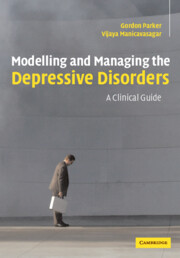Book contents
- Frontmatter
- Contents
- Acknowledgements
- Introduction
- Part I The current model for depressive disorders and its impact on clinical management
- 1 A declaration of independence
- 2 Defining and diagnosing depression
- 3 Depression sub-typing: independence and interdependence
- Part II The diagnosis and management of melancholic and psychotic depression
- Part III An introduction to non-melancholic depression
- Part IV Modelling and managing the non-melancholic depressive disorders
- Appendix 1 The DMI-18 and the DMI-10
- Appendix 2 The CORE system of measuring psychomotor disturbance
- Appendix 3 The temperament and personality measure
- References
- Index
2 - Defining and diagnosing depression
from Part I - The current model for depressive disorders and its impact on clinical management
Published online by Cambridge University Press: 17 August 2009
- Frontmatter
- Contents
- Acknowledgements
- Introduction
- Part I The current model for depressive disorders and its impact on clinical management
- 1 A declaration of independence
- 2 Defining and diagnosing depression
- 3 Depression sub-typing: independence and interdependence
- Part II The diagnosis and management of melancholic and psychotic depression
- Part III An introduction to non-melancholic depression
- Part IV Modelling and managing the non-melancholic depressive disorders
- Appendix 1 The DMI-18 and the DMI-10
- Appendix 2 The CORE system of measuring psychomotor disturbance
- Appendix 3 The temperament and personality measure
- References
- Index
Summary
As much as it is important to know what ‘depression’ is, it is equally important to recognise what it is not. We suggest that ‘depression’ (across the spectrum of its manifestations) is most directly captured by three features:
(i) a depressed mood,
(ii) a lowering of self-esteem or self-worth, and
(iii) an increase in self-criticism.
Phenomenologically, this weighting distinguishes ‘depression’ from anxiety (which is most commonly experienced as a sense of uncertainty, apprehension, insecurity, and fear, as well as hyperarousal (which can then lead to appetite and sleep changes). In grief, something of value to the individual (e. g. a partner, an ideal) is lost, but, in pure instances, the individual's self-esteem is not reduced (only in about one-third of grieving individuals does ‘depression’, with its associated drop in self-esteem feature, develop). As depression and anxiety (in particular) commonly co-exist (with the presence of each increasing the occurrence of the other), many clinicians are tempted to view anxiety and depression as synonymous. We also suggest that the phenomenological distinction of grief from depression is important, particularly in prioritising treatment strategies.
Distinguishing meaningful expressions of ‘depression’ is a less clear-cut process, but the obvious first task here is to contemplate what might distinguish ‘normal depression’ and ‘clinical depression’. Normal fluctuations in mood, even if they distress us, are appropriate, and may even be desirable. To feel ‘alive’ is to think, feel, and react both to our environment and to the people around us. When we stop thinking, feeling, and reacting, we become like automatons or robots.
- Type
- Chapter
- Information
- Modelling and Managing the Depressive DisordersA Clinical Guide, pp. 14 - 20Publisher: Cambridge University PressPrint publication year: 2005

